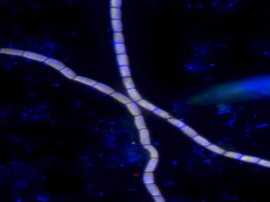It’s easy to overlook what you’re not expecting to see. This was confirmed for Professor Lars Peter Nielsen ten years ago when he discovered electric currents in the seabed that turned out to be due to unknown bacteria: cable bacteria. His revolutionary discovery is changing the world's understanding of bacteria, and in 2017 the Danish National Research Foundation invested DKK 56 million (EUR 7.5 million) in the Center for Electromicrobiology and dedicated research into this surprising organism.
A bacterium found in mud in the Bay of Aarhus is revolutionizing the world's understanding of bacteria. It is composed of thousands of cells in a chain which makes up an electric conductor, and the establishment of the Center for Electromicrobiology at Aarhus University will enable the bacterium to continue to surprise and expand the new understanding.
- Previously, we thought that bacteria were limited to just exchanging material with their surroundings and possibly they could use sunlight. But given that these bacteria are capable of delivering an electric current or living off one, it would seem that they can exploit many more different and more efficient processes. Not least working with other organisms. We can compare it with how electricity and telephone networks gave society a wealth of new opportunities for using energy and communicating, says the centre director, Professor Lars Peter Nielsen, and he continues:
- We’ve been studying mud and bacteria at our department for decades, but no one has previously discovered these unusually long cable bacteria, probably because we weren't expecting them. Now we’re finding them easily in many different samples from both the seabed and lakebeds.

The bacteria act like electrical cables, and therefore they are known as "cable bacteria". Unlike other bacteria, they can conduct electricity over long distances, several centimetres, just like electric cables. The cable can move and grow larger when its cells divide, and it gets energy when electrons are sent through the cable from a material in one location to another material elsewhere.
Lars Peter Nielsen and his colleagues from Aarhus University discovered this in 2012, and their discovery triggered a number of new questions. In 2017, the Danish National Research Foundation invested DKK 56 million (EUR 7.5 million) in a new Center for Electromicrobiology to provide the framework for answering these questions.
- Working on something as important as this is exciting, fun and rewarding. The cable bacteria are a paradigm shift, because they add a new chapter to our understanding of how electricity can be conducted, says Lars Peter Nielsen.
The transport of electrons in the bacteria is fascinating, explains the centre director, not only in the field of microbiological research, but also in relation to technical challenges facing society. Currently, Lars Riis Damgaard, a researcher at the centre, is developing a methodology for mapping soil contamination. His research is in collaboration with a private company, DMR A/S, the Central Denmark Region and the Capital Region of Denmark in a new project called BIOMAP, which has received DKK 11.5 million (EUR 1.5 million) from Innovation Fund Denmark.
- Geophysicists have pondered on electrical phenomena in contaminated sites, but they haven’t been able to explain them. With the discovery of the cable bacteria and our knowledge at the Center for Electromicrobiology, we can explain these phenomena and apply our insight as the basis for a method to map contaminated sites, explains Lars Riis Damgaard.
The goal of the team behind BIOMAP is to develop equipment and software that can measure and interpret the electrical potentials caused by the cable bacteria on contaminated sites. BIOMAP also wants to commercialize the idea, which could serve as a supplement to the existing techniques to map soil contamination and make mapping more efficient. This is important in Denmark, but also in the rest of the world, where people are moving to cities and have to settle in former industrial areas with a higher risk of contamination.
The Center for Electromicrobiology is a so-called Center of Excellence, which the Danish National Research Foundation funds to promote ground-breaking research. In Aarhus, a large group of professors, post docs and students with backgrounds in microbiology, electro-chemistry, molecular biology and nanoscience are working to find out what cable bacteria are, how they function, and what they can do. It is a big job, because all the nooks and crannies of the micro-organism have to be examined and tested.
The DKK 56 million from the Danish National Research Foundation will fund research into the cable bacteria up to 2023, and Centre Director Lars Peter Nielsen hopes that the research into the bacteria will lead to new opportunities and insights.
- Previous studies by ourselves and colleagues have demonstrated that cable bacteria affect natural conversion processes, with consequences for the environment and greenhouse-gas emissions. Another fascinating aspect is the material the bacteria use to conduct electricity. We’ve not conclusively determined its chemistry, but it is an organic material, so it could possibly be used to replace metals and create biodegradable electronics, he explains.
The Center for Electromicrobiology is being funded with DKK 56 million from the Danish National Research Foundation. The centre opened in 2017, and the funding will pay for research into cable bacteria up to and including 2023.